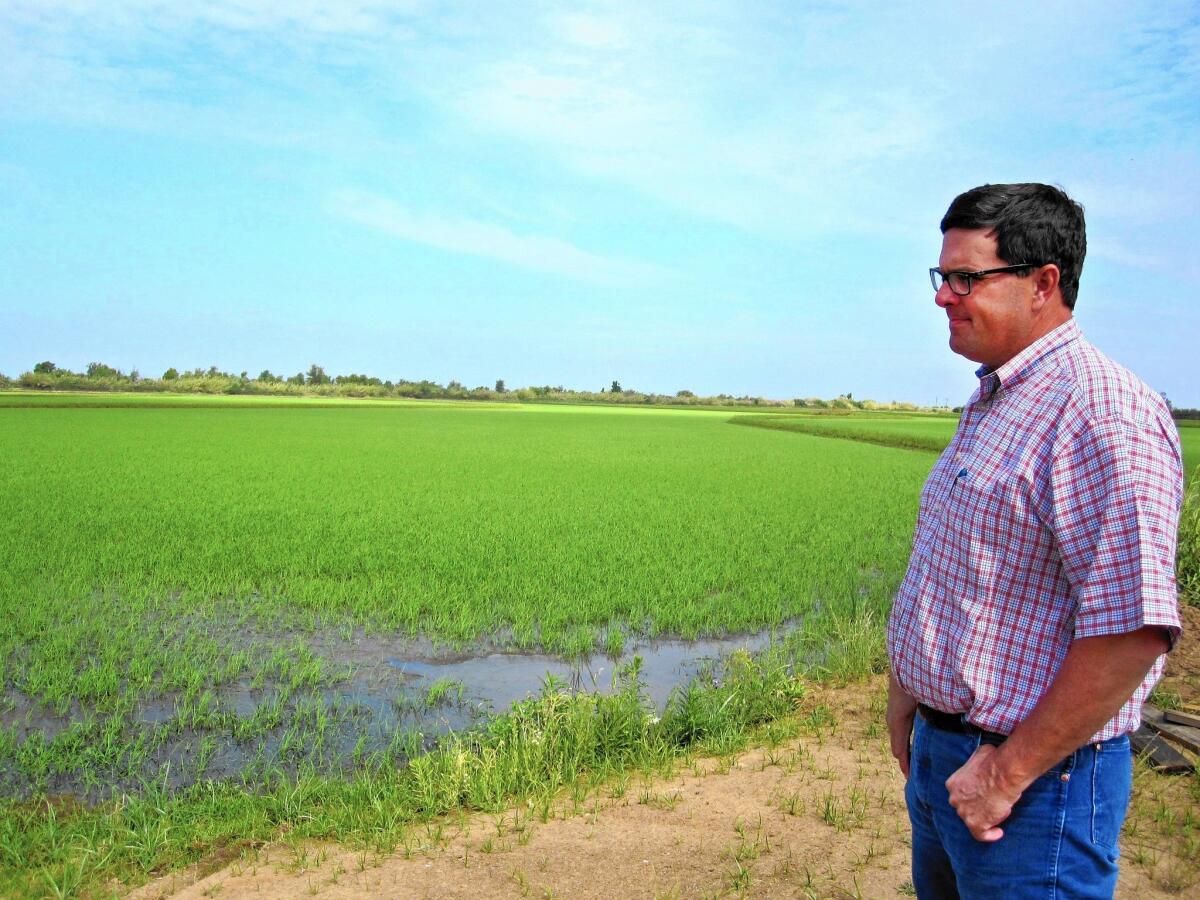California rice farmers find Japanese trade negotiators a bit starchy

Charley Mathews Jr., a fifth-generation farmer in Marysville, surveys his rice paddies in the Sacramento Valley.
reporting from marysville, calif. — For years Charley Mathews Jr. has exported tons of his best Sacramento Valley-grown rice to Japan, but it grates on him that very little of that has ever ended up on the tables of sushi restaurants or Japanese households.
Instead, the Japanese government, which controls rice imports under a 2-decade-old quota system, has given away most of his and other foreign rice as food aid or sold it domestically as animal feed and an ingredient for rice crackers.
“We want recognition,” said Mathews, 48, a fifth-generation California farmer whose great-grandfather began planting rice 80 years ago. He insists that California rice is as good as Japan’s, if only Japanese consumers had a chance to try it.
Expanding U.S. rice shipments to Japan is one of the most contentious and last remaining issues in talks over the sweeping Trans-Pacific Partnership trade accord. The 12-nation deal is expected to be concluded this summer if American lawmakers give President Obama authority to speed passage of trade agreements.
The legislation cleared the Senate last month. And although a clutch of House Republicans has joined many wary Democrats in opposing the bill, the GOP leadership in the House has indicated it could take a vote on the measure Friday, suggesting that it believes there is enough support to hand Obama an important and rare legislative victory.
Rice growers and others in the U.S. agricultural industry stand to be among the biggest winners should the Pacific trade accord go through. American providers of pharmaceuticals, software, films and other internationally traded services also would benefit.
On the other hand, U.S. makers of cars, textiles and other light industrial goods could lose more market share to imports from Japan as well as Vietnam and possibly others.
Yet even as California farmers eye what could be a lucrative expansion into the world’s most discriminating rice market in Japan, their ambitions have been complicated by the state’s severe drought and the surge in the dollar.
The U.S. last year exported $269 million worth of rice to Japan, most of that coming from California. The state’s rice planting this year, however, is expected to be the smallest in about a quarter century. Overall, U.S. farm goods represented $13.2 billion of the $67 billion in total merchandise exports to Japan in 2014.
Despite their relatively small value, rice and some other agricultural goods are usually among the most sensitive in trade talks because of their industry’s enormous political clout in many countries. The U.S. and Japan locked horns over beef and pork last year, and the fight over rice is even more delicate in Japan, where political and demographic forces are pushing against a further opening of that market.
Given the size of the California congressional delegation and the potential importance of their votes to the trade pact’s approval, the state’s 2,000 rice farmers may have an outsized influence on the outcome.
In addition to the symbolism of the small family farm that is part of America’s history, “rice has become an iconic image of America’s problems of opening up overseas markets,” said Jock O’Connell, a trade economist at Beacon Economics in Sacramento.
And that’s true especially in trade relations with Japan, where the U.S. has long complained about non-tariff barriers for foreign cars, electronics and other goods.
With more than 2 million farmers working on mostly small paddies, Japanese rice farming is widely considered inefficient. But farmers represent a core constituency for Prime Minister Shinzo Abe and his Liberal Democratic Party, and Japanese negotiators have been reluctant to give much ground when rice consumption continues to shrink with the nation’s aging population.
It’s a hot-button issue in the U.S. too. The lack of access to Japanese markets for U.S. rice and other farm goods, as well as for automobiles, has long been seen by many Americans as emblematic of Japan’s reluctance to open trade.
Japan allows imports of 770,000 metric tons of rice, about 9% of annual consumption. California farmers account for the lion’s share of that amount, and many of them want Japan to increase its rice imports by 200,000 metric tons or so. The Japanese have been reported to be offering 50,000, which is less than 1% of the total consumption.
“From the beginning, we never sought a total opening because of the sensitivities,” said Bob Cummings, chief operating officer at the USA Rice Federation in Arlington, Va. “But when you’re looking at less than 1%, that’s unacceptable.”
The high end of that range could add tens of millions of dollars to California’s annual rice exports, valued at more than $600 million last year. About a third of that goes to Japan. But experts warn that even a significant increase in the import quota may not help California farmers as much as they hope.
One big stumbling block now is the California drought, which has reduced the acreage of rice planted in the last two years about 25%, according to the California Rice Commission. Given the past and likely future water constraints, economists on both sides of the Pacific wonder whether California farmers can ramp up production even if American officials succeed in breaking open Japan’s rice market.
“Unless farmers figure out more ingenious ways to irrigate their lands, we may not be able to take full advantage” of the trade deal, said O’Connell, the trade expert in Sacramento.
In nearby Yuba City, Jon Munger, operations manager at Montna Farms, hops into his red pickup and drives along the dirt road that bisects a large field. On one side are lush green paddies, inundated with waters from the nearby Feather River. A white-faced ibis, stilts and other birds dance on the surface. On the other side, the square plots are bone dry, covered with browning weeds.
“People from the highway think we’ve got wall-to-wall watered fields,” he said, alluding to the sensitivities stirred by drought-induced ordinances for consumers to ratchet back water use. But he said about 40% of Montna’s entire 4,000-acre farmland was left unplanted this spring for the second year in a row because of water restrictions and costs.
“It’s the most they’ve ever fallowed,” said the 38-year-old. “It’s definitely not sustainable. We need some help from Mother Nature.”
Sure, Munger said, increasing the Japanese rice market would be great for California farmers, especially for operations such as his that specialize in premium short-grain rice used for sushi. But at the moment, he isn’t thinking about that potential benefit.
Another challenge is that the price of Japan’s domestically grown rice has fallen sharply in recent years as production and supplies have outstripped consumption.
At the same time, the value of the Japanese yen has plunged against the dollar, largely reflecting the weakness of Japan’s economy versus America’s, making U.S. exports much more expensive. Since fall 2012, the yen has lost nearly 60% of its value against the dollar.
The upshot is that California exporters of short-grain rice, the sticky variety favored in Japan, have lost practically all of the price advantage they once enjoyed in Japan, said Kazuhito Yamashita, an agricultural policy expert at the Canon Institute for Global Studies in Tokyo.
Ten years ago, he noted, Japanese rice was triple the cost of California’s, and even two years ago, it was 50% more.
With the price gap now gone, Yamashita said, some Japanese trading companies are even thinking about exporting Japanese rice to California. “It’s very amazing,” he said.
Many Japanese also question whether California rice can compete on quality. Foreign rice generally doesn’t have a good reputation among Japanese consumers.
“If I eat California rice immediately after it’s cooked, I can’t tell the difference,” said a Japanese government official, who asked for anonymity given the sensitivity of the trade talks.
“But if I taste it after long hours, I can tell the difference,” he said. A colleague nodded in agreement. “The Japanese rice, even after long hours, is still sticky.”
More to Read
Inside the business of entertainment
The Wide Shot brings you news, analysis and insights on everything from streaming wars to production — and what it all means for the future.
You may occasionally receive promotional content from the Los Angeles Times.








